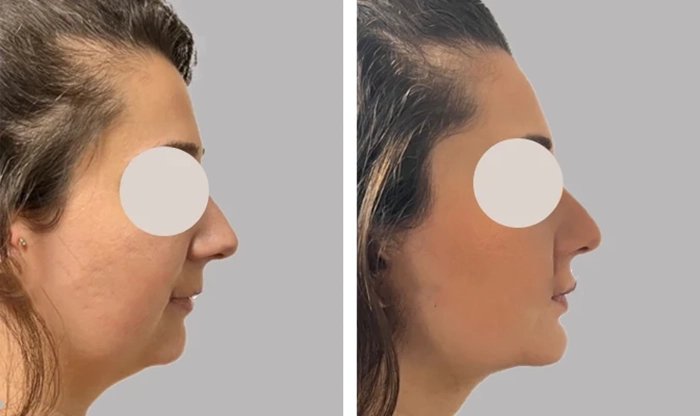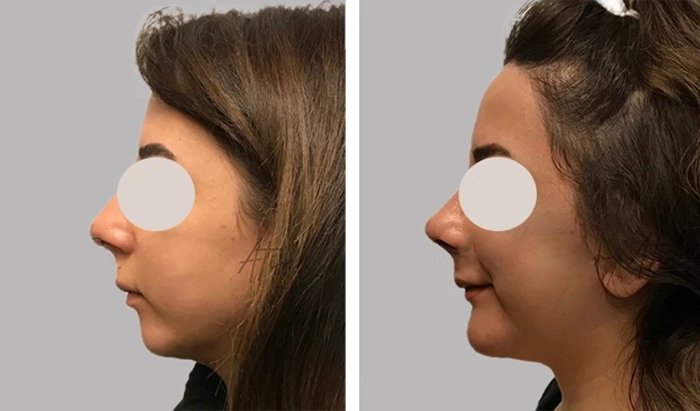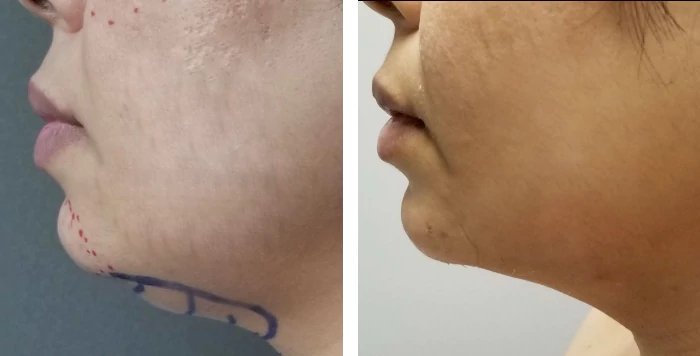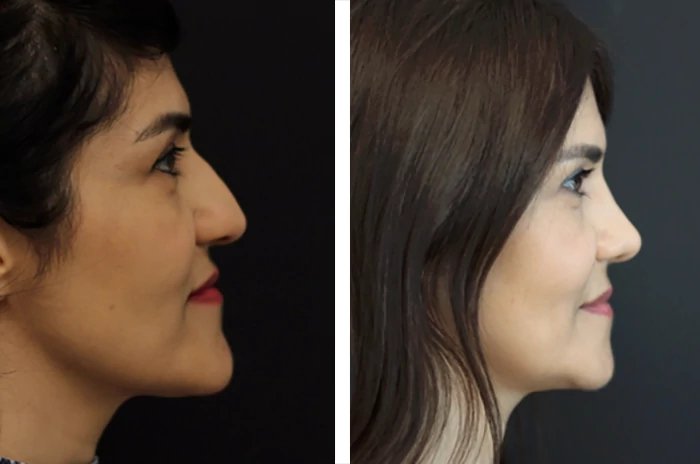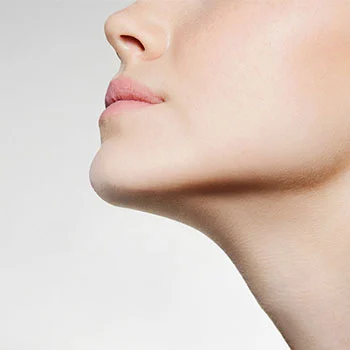What is sliding genioplasty?
Sliding genioplasty is a surgical procedure performed to modify the position and shape of the chin. It involves making a cut in the lower jawbone (mandible) and repositioning the chin segment to achieve the desired aesthetic or functional outcome.
The procedure is typically performed to correct a receding or protruding chin, improve facial harmony, or address bite issues. The repositioned chin segment is fixed in its new position using screws or plates, which provide stability during the healing process. Sliding genioplasty is tailored to each individual's needs and can be combined with other facial procedures if necessary.
Are you a good candidate for sliding genioplasty?
Good candidates for sliding genioplasty typically include individuals who have specific concerns or conditions related to the position, shape, or size of their chin. Some factors that may make someone a suitable candidate for sliding genioplasty include:
- Receding chin: Individuals with a receding or retruded chin (retrognathia) may benefit from sliding genioplasty to improve facial balance and profile.
- Protruding chin: Those with a protruding or prominent chin (prognathism) may opt for sliding genioplasty to achieve a more harmonious facial appearance.
- Facial asymmetry: Sliding genioplasty can help address facial asymmetry caused by chin position discrepancies.
- Bite problems: If the chin position contributes to bite issues, such as an open bite or crossbite, sliding genioplasty may be recommended as part of a comprehensive treatment plan involving orthodontics or jaw surgery.
- Aesthetic concerns: Individuals who are dissatisfied with the shape or size of their chin and desire a more balanced facial appearance may consider sliding genioplasty. An ideal candidate for sliding genioplasty also should have the following characteristics:
- Stable dental occlusion: Candidates for sliding genioplasty should have a stable dental occlusion (bite) to ensure that the procedure does not negatively impact their bite alignment. Any existing site issues should be evaluated and addressed as part of the treatment plan.
- Facial growth completed: It is generally recommended that candidates have completed their facial growth before undergoing sliding genioplasty. This ensures that the procedure will not interfere with natural growth processes
- Good general health: Candidates should be in good overall health, as they will undergo a surgical procedure that requires anesthesia and a period of recovery.
- Realistic expectations: Ideal candidates should have realistic expectations about the outcomes of the surgery. They should understand the potential benefits, limitations, and risks associated with sliding genioplasty.
It is important to consult with an experienced oral and maxillofacial surgeon who can evaluate your specific concerns, facial structure, and dental occlusion to determine if sliding genioplasty is a suitable option for you. They will consider your individual needs, goals, and expectations to provide personalized recommendations and discuss the potential risks and benefits of the procedure.
How is sliding genioplasty performed?
Sliding genioplasty is a surgical procedure used to modify the position and shape of the chin. The general steps involved in performing sliding genioplasty are as follows:
- Anesthesia: The procedure is typically performed under general anesthesia to ensure the patient's comfort and safety throughout the surgery.
- Incision: The surgeon makes an incision inside the mouth, usually along the lower gum line or inside the lower lip. This approach allows for hidden scars and avoids visible external incisions.
- Bone cut: Using specialized instruments, the surgeon carefully makes a precise bone cut (osteotomy) in the lower jawbone (mandible) just below the teeth. The precise location and shape of the cut depend on the desired movement of the chin.
- Repositioning: The chin segment is then mobilized and moved forward, backward, or vertically, depending on the desired outcome. The surgeon positions the chin segment in the new desired location.
- Fixation: The repositioned chin segment is stabilized in its new position using small titanium plates and screws. These fixation devices provide stability and support the bone during the healing process.
- Closure: The incision is closed with dissolvable sutures, and the surgical site is typically covered with surgical dressings.
- Recovery: After the surgery, the patient is monitored in a recovery area until the anesthesia wears off. They may need to stay in the hospital overnight for observation, depending on the surgeon's recommendation.
Postoperative care instructions will be provided, which may include guidelines for diet, oral hygiene, pain management, and follow-up appointments. It is important to note that the specifics of the surgical technique may vary depending on the individual case and the surgeon's preferences. The surgeon will create a treatment plan tailored to the patient's needs, considering factors such as the desired chin position, facial aesthetics, and functional requirements.
How to prepare for the surgery?
Preparing for sliding genioplasty surgery involves several important steps to ensure a smooth and successful procedure. Here are some general guidelines for preparation:
- Consultation and Evaluation: Schedule a consultation with an experienced oral and maxillofacial surgeon. During this initial visit, the surgeon will evaluate your specific case, discuss your concerns and goals, and determine if sliding genioplasty is the appropriate procedure for you.
- Medical Evaluation: Undergo a comprehensive medical evaluation to assess your overall health. This may involve providing your medical history, undergoing blood tests, and possibly obtaining clearance from other medical specialists if necessary.
- Preoperative Instructions: Follow any preoperative instructions provided by your surgeon. These may include fasting for a certain period before surgery, avoiding certain medications or supplements that can increase bleeding risk, and discontinuing smoking or tobacco use.
- Medications: Inform your surgeon about any medications you are currently taking, including prescription, over-the-counter, and herbal supplements. Follow their guidance on which medications to continue or discontinue before the surgery.
- Arrange Transportation and Support: Plan for transportation to and from the surgical facility on the day of the procedure, as you may be under the effects of anesthesia. Additionally, arrange for someone to accompany you during the procedure and provide support during the initial recovery period.
- Home Preparation: Prepare your home for a comfortable recovery. Stock up on soft foods, as your diet may be restricted initially. Create a clean and quiet recovery space with necessary supplies, such as extra pillows, ice packs, and prescribed medications.
- Postoperative Care: Familiarize yourself with postoperative care instructions provided by your surgeon. Understand the recommended diet, oral hygiene practices, pain management techniques, and follow-up appointments.
- Emotional and Mental Preparation: Sliding genioplasty is a surgical procedure, so it is normal to experience some anxiety or emotional stress. Engage in activities that help you relax and mentally prepare for the surgery, such as practicing mindfulness techniques or discussing any concerns with your surgical team.
Remember to communicate openly with your surgeon, ask any questions you may have, and follow their specific instructions for preparation. This will help ensure a safe and successful surgical experience.
What’s the recovery and aftercare like?
The recovery period typically involves some swelling, bruising, and discomfort, which gradually subside over time. Full recovery and final results may take several weeks to months, during which the bone heals and the tissues settle into their new position. Close follow-up with the surgical team is necessary to monitor the healing process and address any concerns.
The recovery and aftercare process following sliding genioplasty surgery typically involves the following aspects:
- Hospital stay: Depending on the surgical plan and your surgeon's recommendation, you may need to stay in the hospital overnight for observation. This allows the medical team to monitor your initial recovery and manage any immediate postoperative concerns.
- Swelling and discomfort: Swelling and discomfort are common after sliding genioplasty. You may experience swelling around the chin, lower face, and neck area. Applying cold compresses to the surgical site in the first 24-48 hours can help reduce swelling. Your surgeon may prescribe pain medications to manage any discomfort during the initial recovery period.
- Diet: You will likely be advised to follow a soft or liquid diet for the first few days or weeks following surgery. This ensures that the healing tissues are not subjected to excessive strain or pressure. Gradually, you can transition to a more regular diet as advised by your surgeon.
- Oral hygiene: Maintaining good oral hygiene is crucial during the recovery period. Your surgeon will provide specific instructions on how to clean your mouth, teeth, and surgical site. Gentle rinsing with a prescribed mouthwash may be recommended, and brushing near the surgical area should be done with care.
- Activity restrictions: It is important to avoid strenuous activities, heavy lifting, and intense exercise during the initial weeks of recovery. These activities can increase swelling and bleeding and negatively impact the healing process. Your surgeon will provide guidance on when it is safe to resume normal activities.
- Follow-up appointments: You will have scheduled follow-up appointments with your surgeon to monitor your healing progress. These appointments allow your surgeon to assess the surgical site, remove any sutures if necessary, and address any concerns or questions you may have.
- Healing and final results: The complete healing process and final results of sliding genioplasty can take several weeks to months. Swelling gradually subsides, and the tissues settle into their new position. It is important to have realistic expectations and understand that the full aesthetic outcome may not be immediately apparent.
During the recovery and aftercare period, it is crucial to closely follow your surgeon's postoperative instructions. If you experience excessive bleeding, severe pain, infection signs, or any unexpected complications, contact your surgeon immediately.
Remember that individual recovery experiences may vary, and it is important to consult with your surgeon for personalized guidance tailored to your specific case.
What are the potential risks and complications?
While sliding genioplasty is generally considered a safe procedure, it is important to be aware of potential risks and complications. These can include:
- Infection: There is a risk of infection at the surgical site. Your surgeon will provide instructions on how to minimize this risk, such as maintaining good oral hygiene and taking prescribed antibiotics if necessary.
- Bleeding: Some bleeding is expected during and immediately after the surgery. However, excessive bleeding or hematoma formation (collection of blood) can occur, requiring medical attention.
- Swelling and bruising: Swelling and bruising are common after sliding genioplasty and typically subside over time. However, in some cases, prolonged or excessive swelling and bruising may occur.
- Nerve damage: There is a small risk of nerve damage during the procedure, which can result in temporary or, rarely, permanent numbness or altered sensation in the chin, lower lip, or teeth. This risk is minimized by the surgeon's expertise and careful technique.
- Malposition or asymmetry: In some cases, the repositioned chin segment may not achieve the desired aesthetic outcome or may result in asymmetry. Revision surgery may be required to address these issues.
- Impaired healing: Factors such as smoking, poor nutrition, certain medical conditions, or medications can impair the healing process. It is important to follow your surgeon's instructions and maintain a healthy lifestyle to optimize healing.
- Bite changes: Sliding genioplasty can alter the relationship between the upper and lower teeth, potentially affecting the bite. In some cases, additional orthodontic treatment or jaw surgery may be needed to address bite discrepancies.
- Scarring: Incisions made inside the mouth generally result in minimal visible scarring. However, individual healing and scar formation can vary.
It is important to discuss these potential risks and complications with your surgeon during the consultation process. They will evaluate your specific case, address any concerns, and provide you with personalized information regarding the risks and benefits of sliding genioplasty.
How much does sliding genioplasty cost?
The cost of sliding genioplasty can vary depending on several factors, including the geographical location, the surgeon's experience and expertise, the complexity of the procedure, and the specific medical facility where the surgery is performed.
On average, the cost of sliding genioplasty in the United States can range from $4,000 to $10,000 or more. This estimate typically includes the surgeon's fees, anesthesia fees, facility fees, preoperative tests, postoperative care, and follow-up appointments. However, it's important to note that these figures are approximate and can vary significantly.
It is advisable to consult with a qualified oral and maxillofacial surgeon to get an accurate estimate of the cost based on your individual case and the specific details of the procedure. Your surgeon's office can provide you with a breakdown of the costs and help you understand the financial aspects, including any potential insurance coverage or financing options that may be available to you.
What are other alternatives to sliding genioplasty?
There are several alternatives to sliding genioplasty that can address concerns about the position or shape of the chin. The most appropriate alternative will depend on the specific concerns and goals of the individual. Some alternatives to sliding genioplasty include:
- Chin implants: Chin implants involve the placement of a synthetic implant to enhance the size and shape of the chin. This procedure is suitable for individuals seeking to increase chin projection or improve chin contour without modifying the position of the chin bone.
- Injectable fillers: Dermal fillers, such as hyaluronic acid-based fillers, can be used to augment the chin non-surgically. This approach is temporary and provides a less permanent solution compared to surgical interventions. Injectable fillers can add volume and improve chin projection, but their effects are not permanent and require periodic maintenance treatments.
- Genioglossus advancement: Genioglossus advancement is a surgical procedure that involves repositioning the genioglossus muscle to improve airway obstruction caused by a receding chin. This procedure is primarily used to address sleep apnea or other breathing-related issues associated with a small or recessed chin.
- Orthodontic treatment: In some cases, orthodontic treatment, such as braces or aligners, can help improve the appearance of the chin by correcting dental misalignments or bite issues. By aligning the teeth and jaw, orthodontic treatment can indirectly enhance the overall facial profile and balance.
It is important to consult with an experienced oral and maxillofacial surgeon or a qualified plastic surgeon to discuss your concerns and explore the most suitable alternatives to sliding genioplasty. They will evaluate your specific case and recommend the most appropriate treatment option based on your individual needs and goals.
Sliding genioplasty vs. chin implants: pros and cons
Both sliding genioplasty and chin implants are effective methods for enhancing the appearance of the chin. Here are the pros and cons of each procedure:
Advantages of sliding genioplasty
- Customizable results: Sliding genioplasty allows for precise repositioning of the chin bone, making it a suitable option for individuals with complex chin concerns, such as asymmetry or significant vertical or horizontal adjustments.
- Stability: Since sliding genioplasty involves repositioning the chin bone and fixing it in place with plates and screws, the results are generally stable and long-lasting.
- Natural look and feel: By modifying the actual bone structure of the chin, sliding genioplasty can provide a more natural and harmonious appearance to the face.
Disadvantages of sliding genioplasty
- Surgical complexity: Sliding genioplasty is a more invasive surgical procedure compared to chin implants. It requires bone cutting, mobilization, and fixation, which may involve a longer recovery period and increased risk of complications.
- Higher cost: Sliding genioplasty tends to be more expensive than chin implants due to the complexity of the surgery and the need for anesthesia, hospital stay, and potential follow-up appointments.
Advantages of chin implants
- Simplicity: Chin implant surgery is relatively simpler and less invasive compared to sliding genioplasty, typically requiring a shorter surgical procedure and recovery time.
- Customizable options: Chin implants come in various sizes and shapes, allowing for customization to match individual preferences and desired outcomes.
- Cost: Chin implants generally have a lower cost compared to sliding genioplasty, making them a more affordable option for individuals seeking chin augmentation.
Disadvantages of chin implants
- Limited adjustability: Unlike sliding genioplasty, chin implants cannot address complex chin concerns such as vertical or asymmetrical adjustments. They primarily provide augmentation in terms of projection and contour.
- Potential for shifting or displacement: There is a slight risk of chin implants shifting or becoming displaced over time, which may require revision surgery.
- Potential for implant-related complications: Although rare, there is a small risk of complications such as infection, implant malposition, or implant rejection with chin implants.
Ultimately, the choice between sliding genioplasty and chin implants depends on the individual's specific concerns, goals, and the recommendations of a qualified surgeon. It is essential to consult with a skilled professional who can evaluate your case and guide you toward the most suitable option for achieving the desired results.
FAQs
Can I talk after sliding genioplasty?
Yes, you can talk after sliding genioplasty, but there may be temporary difficulty due to swelling and stiffness. Speech therapy may be recommended to aid in the recovery process.
How soon after sliding genioplasty can I eat normally?
The timeline for returning to a normal diet after sliding genioplasty varies, but it can range from a few days to several weeks, depending on individual healing and the surgeon's guidance.
How painful is sliding genioplasty?
Sliding genioplasty can be associated with varying levels of pain, which is typically managed with prescribed pain medications. Pain experiences can vary among individuals, and the surgeon will provide appropriate pain management strategies.

